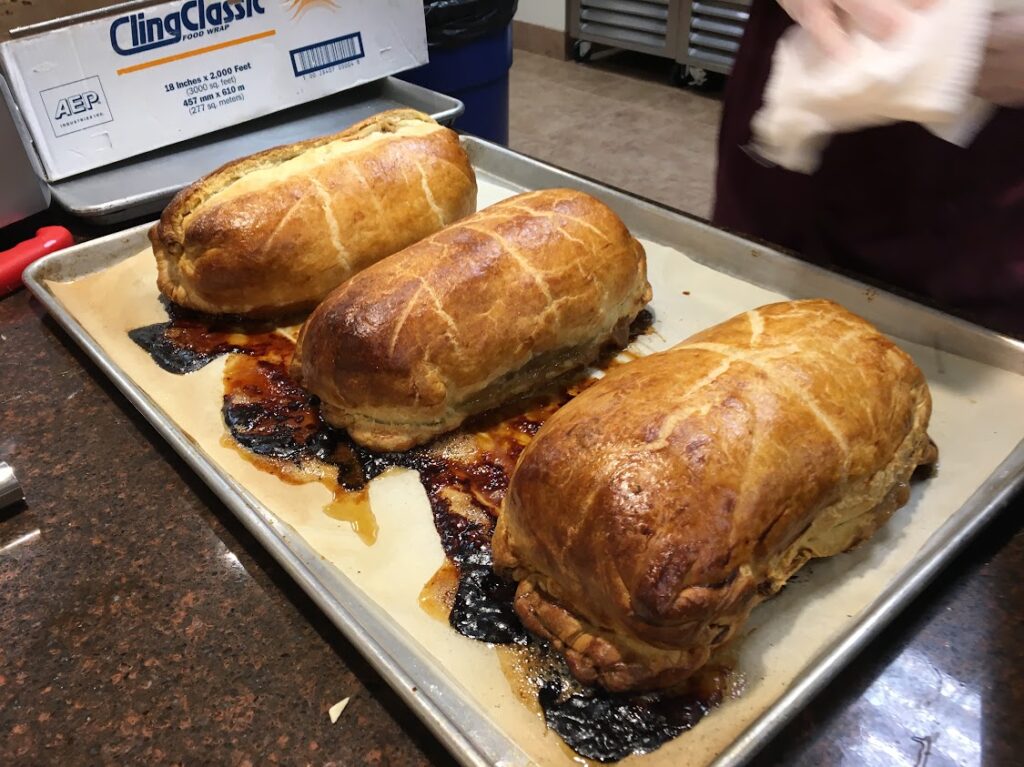
You’ve seen it made on every cooking show and by every famous chef. Beef Wellington is a classic main course that has probably run its course but it is still incredibly delicious and surprisingly a lot of fun to make. As seen in the pictures, it probably won’t turn out as seen on TV but even with imperfections it will be a dish you will love to make for special occasions.
Using a high end cut of meat like center cut tenderloin is extremely expensive and might scare you away from buying it, especially when doing a preparation like Beef Wellington that can easily turn into a nightmare. However, if you follow these instructions you will end up with with a great end product that will be a crowd pleaser.
First step is to make your Duxelles so that is ready to go when it is time to assemble everything.
Add mushrooms, shallots, garlic, and thyme to a food processor and pulse until all ingredients are finely chopped. You can do this without a food processor, if you decide to just chop it be patient and make sure it is very finely chopped.
Heat a sauté pan over medium heat. Add butter and olive oil to the pan and allow the butter to melt and coat the bottom of the pan. Add the mushroom mixture to the pan then season with a pinch of salt and pepper. Let the mushrooms cook down until all of the liquid from the mushrooms has evaporated. This may take a bit of time but it is crucial to make sure there is little to no moisture left. If there is too much moisture left it will affect the texture of the puff pastry when cooking and carving the Wellington.
Let your Duxelles cool to room temp or refrigerate until ready to use. Making this a day in advance could help out greatly.
Remove your tenderloin from the refrigerator and let it sit out for an hour or more so that it approaches room temperature.
Preheat your oven to 425 degrees Fahrenheit. Might be a little premature to start the oven now but it is one less thing to forget down the road.
Generously season your tenderloin with salt and pepper. Remember that the center of the tenderloin will not be seasoned so it is important to season the outside well.
Heat a large sauté pan over high heat. Once the pan is very hot you can add olive oil. Carefully lay the tenderloin into the pan and sear it in the hot oil on all surfaces, including the ends. Once there is a good sear on all surfaces you can turn off the heat and remove the tenderloin from the pan and set it aside.
After about 15 minutes you can now brush the tenderloin with Dijon mustard.
Lay out a long sheet of plastic wrap, about 18 inches long. Take your sliced prosciutto and lay them in a rectangle. Try to shingle the prosciutto so that they will completely wrap around the tenderloin when the time comes.
Spread the Duxelles evenly across the prosciutto from edge to edge while trying to maintain the same thickness throughout.
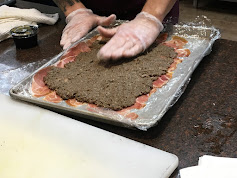
Lay the tenderloin, on one of the long edges, on top of the Duxelles. Carefully, pull up one edge of the plastic wrap, allowing the tenderloin to slowly roll and be wrapped by the prosciutto and Duxelles. Do your best to roll and wrap the tenderloin tightly. The tips of the tenderloin will have excess prosciutto draped over top, fold them neatly on top of one another. Once completely wrapped, roll and seal the edges of the plastic wrap tightly.
Place the rolled tenderloin in the refrigerator 30 minutes so that the fat in the prosciutto tightens up a bit and forms around the tenderloin.
Lay your puff pastry sheets out and press them together to make one large sheet.
Remove the tenderloin from the refrigerator and unwrap. Lay the tenderloin on the long edge of the puff pastry and tightly roll it. If there is an excessive amount of pastry make sure you trim it so that there is not too much overlap. Tuck the sides of the pastry underneath the end of the tenderloin so that there are no openings. This step takes some practice, it won’t be perfect the first time but what you will learn from the first time will make the second time that much better.
Brush the egg wash on all exposed surfaces of the puff pastry then lightly season the top with coarse salt. If you are feeling fancy, now is the time to gently score the pastry just be careful not to score too deep and cut through the pastry.
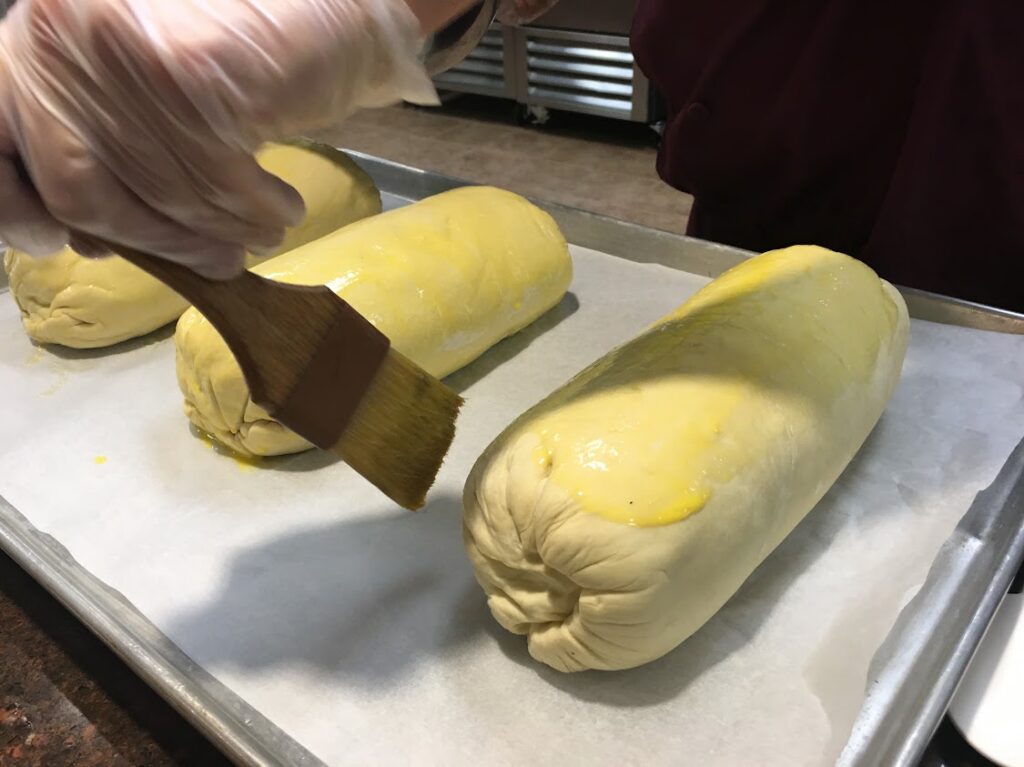
Place the Beef Wellington on a baking sheet lined with parchment paper and place in the oven for 20 minutes. Reduce the oven temperature to 400 degrees then continue to cook for another 30 minutes or until the internal temperature of the tenderloin is between 125-130 degrees Fahrenheit. If you have a meat thermometer that is designed to stay in a roast while being cooked then you will get the perfect cook every time. It is worth investing in.
Let the Wellington rest for 15 minutes before slicing 1″ slices with a sharp knife and serving. A serrated knife will work well just be careful not to break the puff pastry away from the roast.
Practice makes perfect with this recipe so allow yourself room for error and growth the first couple of tries.
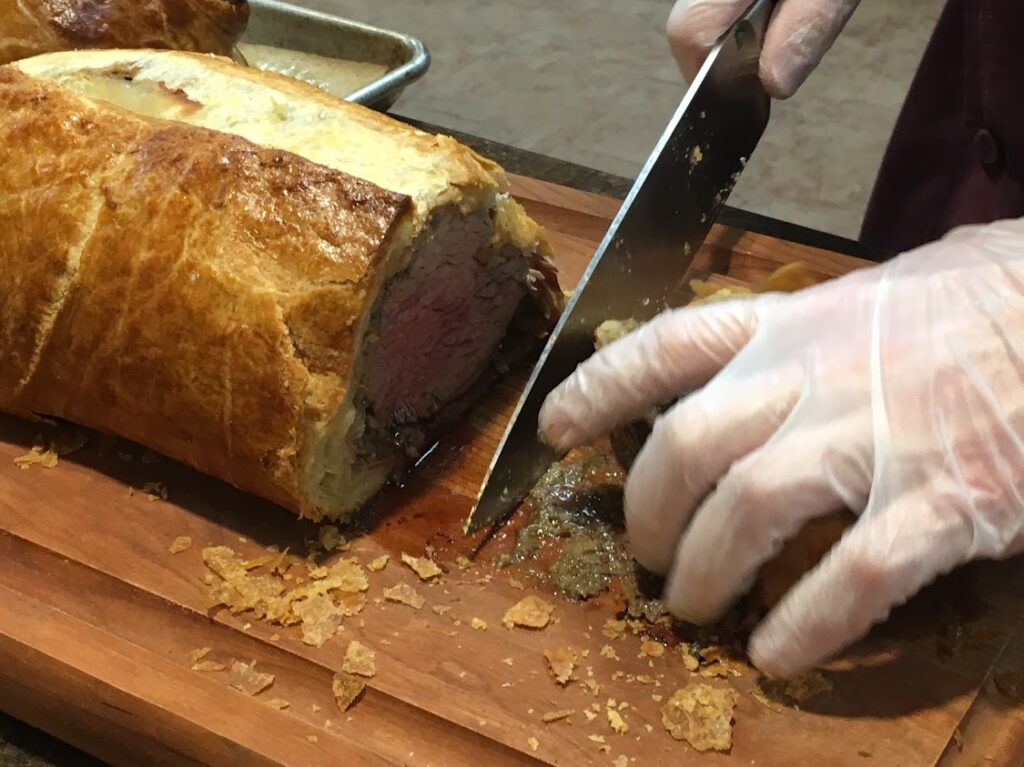
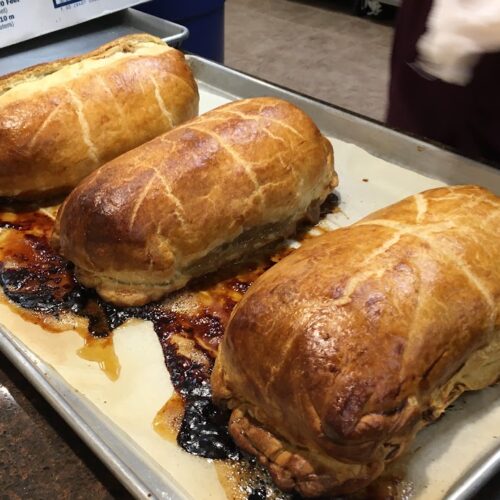
Beef Wellington
Ingredients
Beef Wellington
- 3 lbs Center Cut Tenderloin
- 1 tbsp Olive Oil
- Salt and Pepper Enough to generously coat the fillet
- 2 cups Duxelles
- 12 Slices of Prosciutto
- 2 tbsp Dijon
- 2 Puff Pastry Sheets
- 2 Lightly Beaten Eggs
- 1/2 teaspoon Salt To season puff pastry
Duxelles
- 1.5 lbs Button Mushrooms
- 2 Shallots
- 4 Cloves of Garlic
- 2 Sprigs of Thyme Leaves only
- 2 tbsp Salted Butter
- 2 tbsp Olive Oil
- Salt and Black Pepper Season to taste
Instructions
Beef Wellington
- Remove tenderloin from the refrigerator and allow to sit out for an hour before cooking.
- Preheat Oven to 425 degrees.
- Season your tenderloin with salt and pepper.
- Heat a large sauté pan over high heat. Once the pan is very hot; add the olive oil. Sear the tenderloin, in the hot oil, on all sides and on the ends. Remove from the pan and set aside.
- Brush the tenderloin with Dijon mustard.
- Lay out a long sheet of plastic wrap, lay down slices of prosciutto in a rectangle. Try to shingle them so they will completely wrap around the tenderloin. Spread your Duxelles across the prosciutto all the way to each edge.
- Lay the tenderloin, on one of the long edges, on top of the Duxelles. Carefully pull up one edge of the plastic wrap, allowing the tenderloin to, slowly, roll and be wrapped by the prosciutto and Duxelles. Once completely wrapped, roll and seal the edges of the plastic wrap. Place the tenderloin in the refrigerator for thirty minutes.
- Lay your puff pastry sheets out and press them together, making one large sheet. Remove the tenderloin from the refrigerator and unwrap from the plastic wrap. Lay the tenderloin on the long edge of the puff pastry; tightly roll it. If there is an excessive amount of pastry, trim it so that it doesn’t overlap too much. Tuck the sides of the puff pastry underneath so there are no openings.
- Lightly sprinkle the top of the pastry with salt then brush the egg wash the top and sides of the puff pastry.
- Place in the oven at 425 degrees for 20 minutes, reduce the heat to 400 degrees then cook for another 30 minutes or until the internal temperature is between 125-130 degrees. Let rest 15 minutes before slicing with a serrated knife. Be careful when slicing, do your best to keep the puff pastry from breaking away from the roast.
Duxelles
- Add mushrooms, shallots, garlic, and thyme to a food processor and pulse until all ingredients are finely chopped. (If you don’t have a food processor just chop everything very small)
- Heat a sauté pan over medium heat. Add butter and olive oil to the pan and allow the butter to melt. Add the mushroom mixture to the pan and let cook until all liquid from the mushrooms has evaporated. This will take some time, be patient, it is essential that the Duxelles is dry.
- Season with salt and pepper.
